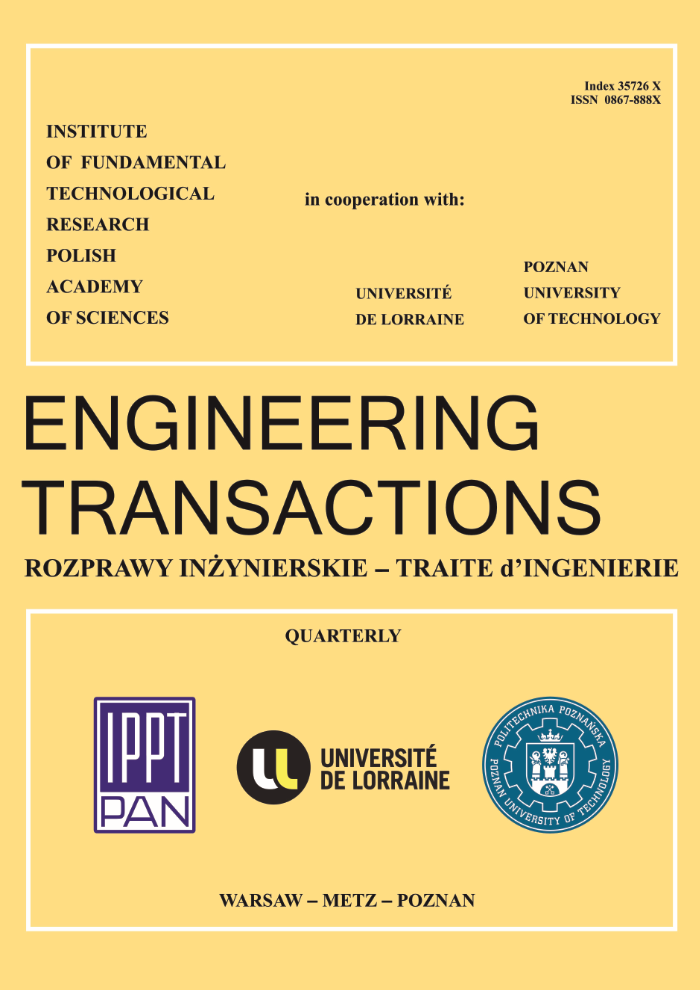Abstract
The best methods available nowadays for modelling the propagation of very short (duration less than 100 fs), ultrawideband electromagnetic signals in physical media are the asymptotic ones. Numerical methods loose their traditional leadership due to their inability to handle rapid oscillations of the propagating signal. Therefore it is important to create accurate asymptotic models of propagation which can be used as a reference. In this paper a new description of primary precursor in a dispersive Lorentz medium is given, based on uniform asymptotic theory of evaluation of integrals and a new approximate solution to the distant saddle point equation. The new representation of the signal in the medium is illustrated graphically and compared with the Oughstun-Sherman representation.References
1. C.J.F. BÖTTCHER and P. BORDEWUK, Theory of electric polarization, vol. II, Elsevier, Amsterdam 1978.
2. A. SOMMERFELD, Über die Fortpflanzung des Lichtes in disperdierenden Medien, Ann. Phys. (Lepzig), 44, 177–202, 1914.
3. L. BRILLOUIN, Über die Fortpflanzung des Lichtes in disperdierenden Medien, Ann. Phys. (Lepzig), 44, 203–240, 1914.
4. L. BRILLOUIN, Wave propagation and group velocity, Academic, New York 1960.
5. K.E. OUGHSTUN and G.C. SHERMAN, Propagation of electromagnetic pulses in a linear dispersive medium with absorption (the Lorentz medium), J. Opt. Soc. Am. B, 817–849, 1988.
6. K.E. OUGHSTUN and G.C. SHERMAN, Uniform asymptotic description of electromagnetic pulse propagation in a linear dispersive medium with absorption (the Lorentz medium), J. Opt. Soc. Am. A 6, 1394–1420, 1989.
7. K.E. OUGHSTUN and G.C. SHERMAN, Uniform asymptotic description of ultrashort rectangular optical pulse propagation in a linear, causally dispersive medium, Phys. Rev. A 41, 6090–6113, 1990.
8. K.E. OUGHSTUN, Pulse propagation in a linear, casusally dispersive medium, Proc. IEEE 79, 1379–1390, 1991.
9. K.E. OUGHSTUN, Noninstantaneous, finite rise-time effects on the precursor field formation in linear dispersive pulse propagation, J. Opt. Soc. Am. A 12, 1715–1729, 1995.
10. G.C. SHERMAN and K.E. OUGHSTUN, Energy-velocity description of pulse propagation in absorbing, dispersive dielectrics, J. Opt. Soc. Am. B 12, 229–247, 1995.
11. K.E. OUGHSTUN and G.C. SHERMAN, Electromagnetic pulse propagation in casual dielectrics, vol. 16, Springer, Berlin 1997.
12. L.B. FELSEN [Ed.], Transient electromagnetic fields, p. 65, Springer-Verlag, Berlin 1976.
13. H.M. NUSSENZVEIG, Causality and dispersion relations, Chap. 1, Academic, New York 1972.
14. A. CIARKOWSKI, Asymptotic analysis of propagation of a signal with finite rise time in a dispersive, lossy medium, Arch. Mech. 49, 5, 877–892, 1997.
15. A. CIARKOWSKI, Frequency dependence on space-time for electromagnetic propagation in dispersive medium, Arch. Mech. 51, 1, 35–46, 1999.
16. R.A. HANDELSMAN and N. BLEISTEIN, Uniform asymptotic expansions of integrals that arise in the analysis of precursors, Arch. Ration. Mech. Anal. 35, 267–283, 1969.
17. N. BLEISTEIN and R. A. HANDELSMAN, Asymptotic expansions of integrals, Ch. 9, Holt, Rinehart and Winston, 1975.
18. J.D. JACKSON, Classical electrodynamics, Ch. 7, John Wiley and Sons, New York 1975.
2. A. SOMMERFELD, Über die Fortpflanzung des Lichtes in disperdierenden Medien, Ann. Phys. (Lepzig), 44, 177–202, 1914.
3. L. BRILLOUIN, Über die Fortpflanzung des Lichtes in disperdierenden Medien, Ann. Phys. (Lepzig), 44, 203–240, 1914.
4. L. BRILLOUIN, Wave propagation and group velocity, Academic, New York 1960.
5. K.E. OUGHSTUN and G.C. SHERMAN, Propagation of electromagnetic pulses in a linear dispersive medium with absorption (the Lorentz medium), J. Opt. Soc. Am. B, 817–849, 1988.
6. K.E. OUGHSTUN and G.C. SHERMAN, Uniform asymptotic description of electromagnetic pulse propagation in a linear dispersive medium with absorption (the Lorentz medium), J. Opt. Soc. Am. A 6, 1394–1420, 1989.
7. K.E. OUGHSTUN and G.C. SHERMAN, Uniform asymptotic description of ultrashort rectangular optical pulse propagation in a linear, causally dispersive medium, Phys. Rev. A 41, 6090–6113, 1990.
8. K.E. OUGHSTUN, Pulse propagation in a linear, casusally dispersive medium, Proc. IEEE 79, 1379–1390, 1991.
9. K.E. OUGHSTUN, Noninstantaneous, finite rise-time effects on the precursor field formation in linear dispersive pulse propagation, J. Opt. Soc. Am. A 12, 1715–1729, 1995.
10. G.C. SHERMAN and K.E. OUGHSTUN, Energy-velocity description of pulse propagation in absorbing, dispersive dielectrics, J. Opt. Soc. Am. B 12, 229–247, 1995.
11. K.E. OUGHSTUN and G.C. SHERMAN, Electromagnetic pulse propagation in casual dielectrics, vol. 16, Springer, Berlin 1997.
12. L.B. FELSEN [Ed.], Transient electromagnetic fields, p. 65, Springer-Verlag, Berlin 1976.
13. H.M. NUSSENZVEIG, Causality and dispersion relations, Chap. 1, Academic, New York 1972.
14. A. CIARKOWSKI, Asymptotic analysis of propagation of a signal with finite rise time in a dispersive, lossy medium, Arch. Mech. 49, 5, 877–892, 1997.
15. A. CIARKOWSKI, Frequency dependence on space-time for electromagnetic propagation in dispersive medium, Arch. Mech. 51, 1, 35–46, 1999.
16. R.A. HANDELSMAN and N. BLEISTEIN, Uniform asymptotic expansions of integrals that arise in the analysis of precursors, Arch. Ration. Mech. Anal. 35, 267–283, 1969.
17. N. BLEISTEIN and R. A. HANDELSMAN, Asymptotic expansions of integrals, Ch. 9, Holt, Rinehart and Winston, 1975.
18. J.D. JACKSON, Classical electrodynamics, Ch. 7, John Wiley and Sons, New York 1975.






